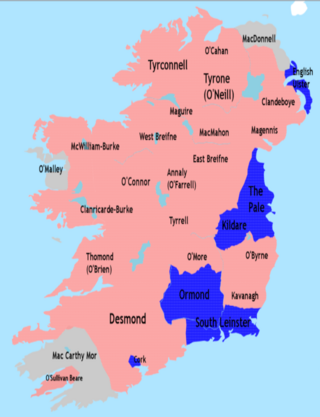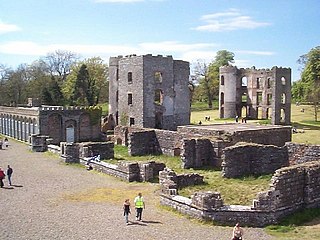| |||||
| Centuries: | |||||
|---|---|---|---|---|---|
| Decades: | |||||
| See also: | Other events of 1561 List of years in Ireland | ||||
Events from the year 1561 in Ireland.
| |||||
| Centuries: | |||||
|---|---|---|---|---|---|
| Decades: | |||||
| See also: | Other events of 1561 List of years in Ireland | ||||
Events from the year 1561 in Ireland.
Sorley Boy MacDonnell, also spelt as MacDonald, Scoto-Irish chief, was the son of Alexander MacDonnell, lord of Islay and Kintyre (Cantire), and Catherine, daughter of the Lord of Ardnamurchan, both in Scotland. MacDonnell is best known for establishing the MacDonnell clan in Antrim, Ireland, and resisting the campaign of Shane O'Neill and the English crown to expel the clan from Ireland. Sorley Boy's connection to other Irish Catholic lords was complicated, but also culturally and familiarly strong: for example, he married Mary O'Neill the daughter of Conn O'Neill. He is also known in English as Somerled and Somerled of the yellow hair.

Hugh O'Neill, was an Irish Gaelic lord, Earl of Tyrone and was later created The Ó Néill Mór, Chief of the Name. O'Neill's career was played out against the background of the Tudor conquest of Ireland, and he is best known for leading the resistance during the Nine Years' War, the strongest threat to Tudor authority in Ireland since the revolt of Silken Thomas.

Sir Henry Sidney, Lord Deputy of Ireland, was the eldest son of Sir William Sidney of Penshurst, a prominent politician and courtier during the reigns of Henry VIII and Edward VI, from both of whom he received extensive grants of land, including the manor of Penshurst in Kent, which became the principal residence of the family.

Shane O'Neill, was an Irish chieftain of the O'Neill dynasty of Ulster in the mid-16th century. Shane O'Neill's career was marked by his ambition to be the O'Neill—sovereign of the dominant O'Neill family of Tír Eoghain—and thus overlord of the entire province. This brought him into conflict with competing branches of the O'Neill family and with the English government in Ireland, who recognised a rival claim. Shane's support was considered worth gaining by the English even during the lifetime of his father Conn O'Neill, 1st Earl of Tyrone. But rejecting overtures from Thomas Radclyffe, 3rd Earl of Sussex, the lord deputy from 1556, Shane refused to help the English against the Scottish settlers on the coast of Antrim, allying himself for a short time instead with the MacDonnells, the most powerful of these settlers, Shane viewed the Scottish settlers as invaders, but decided to stay his hand against them with hopes of using them to strengthen his position with the English; however, tensions quickly boiled over and he declared war on the Scottish MacDonnell's defeating them at the Battle of Glentaisie despite the MacDonnells calling for reinforcements from Scotland. The Scottish MacDonnells would later assassinate Shane O'Neill and collect the bounty on his head.

Thomas Radclyffe, 3rd Earl of Sussex KG, was Lord Deputy of Ireland during the Tudor period of English history, and a leading courtier during the reign of Elizabeth I.
Calvagh O'Donnell, eldest son of Manus O'Donnell, was an Irish King of Tyrconnell of the mid-16th century. He was king and chief of the O'Donnell dynasty based in Tyrconnell in western Ulster. He is best known for his conflict with Shane O'Neill - a dispute that involved the intervention of the English government in Ireland on Calvagh's side.

The Nine Years' War, sometimes called Tyrone's Rebellion, took place in Ireland from 1593 to 1603. It was fought between an Irish alliance—led mainly by Hugh O'Neill of Tyrone and Hugh Roe O'Donnell of Tyrconnell—against English rule in Ireland, and was a response to the then-ongoing Tudor conquest of Ireland. The war was fought in all parts of the country, but mainly in the northern province of Ulster. The Irish alliance won some important early victories, such as the Battle of Clontibret (1595) and the Battle of the Yellow Ford (1598), but the English won a decisive victory against the alliance and their Spanish allies in the siege of Kinsale (1601–02). The war ended with the Treaty of Mellifont (1603). Many of the defeated northern lords left Ireland to seek support for a new uprising in the Flight of the Earls (1607), never to return. This marked the end of Gaelic Ireland and led to the Plantation of Ulster.
The Battle of Glentaisie, was a battle between the native Ulster Irish and Scottish settlers the MacDonnell's fought in the north of Ulster on 2 May 1565. The result was a victory for Shane O'Neill over the Clan MacDonald of Dunnyveg. The conflict was a part of the political and military struggle, involving the English and occasionally the Scots, for control of northern Ireland. Although the MacDonalds were a Scottish family, based principally on the island of Islay in the Hebrides, they had long been associated with the Gaelic polity rather than the Kingdom of Scotland.
Events from the year 1562 in Ireland.
Events from the year 1559 in Ireland.
Events from the year 1590 in Ireland.
Events from the year 1600 in Ireland.
Events from the year 1566 in Ireland.
Events from the year 1565 in Ireland.
Events from the year 1567 in Ireland.
Events from the year 1563 in Ireland.
Lady Frances Radclyffe was an English noblewoman, who early in the reign of Queen Elizabeth I of England became one of her Maids of Honour. It was at the royal court when Frances attracted the attention of visiting Irish chieftain Shane O'Neill, who was searching for a "proper English wife" and made her a proposal of matrimony, which she refused to consider. She later married Sir Thomas Mildmay, by whom she had two sons.

Shane's Castle, formerly Edenduffcarrick is a ruined castle near Randalstown in County Antrim, Northern Ireland, having been destroyed by fire in 1816. The castle is on the north-east shores of Lough Neagh. Built in 1345 by a member of the Clandeboy O'Neill dynasty, it was originally called Eden-duff-carrick. Shane MacBrien O'Neill changed the name to Shane's Castle in 1722.
Events from the year 1557 in Ireland.
Brian Ó Néill, Baron Dungannon was an Irish aristocrat of the Elizabethan era. He was part of the O'Neill dynasty, a powerful Gaelic family in Ulster.